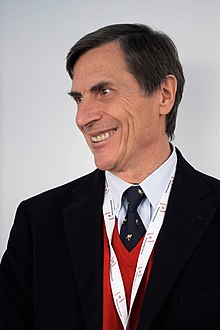Alberto Mantovani
Alberto Mantovani (born October 29, 1948 in Milan ) is an Italian doctor ( oncology , immunology ).
Life
Mantovani studied medicine in Milan with a Laureate in Medicine and Surgery in 1973. He then specialized in oncology at the University of Pavia (1976). In 1975/76 he was at the Chester Beatty Research Institute in Sutton in the tumor immunology department and in 1978/79 in the laboratory for immunodiagnosis of the National Institutes of Health in Bethesda (Maryland) . From 1979 he was a senior scientist at the Istituto di Ricerche Farmacologiche “Mario Negri” in Milan, where he headed the Immunology Laboratory from 1981 and the Immunology and Cell Biology Department from 1996 to 2005. He was also Professor of General Pathology at the University of Brescia from 1994 to 2001 . From 2001 to 2014 he was Professor of Pathology at the University of Milan and from 2014 at the Humanitas University. From 2005 he was scientific director of the Istituto Clinico Humanitas and president of the Fondazione Humanitas per la Ricerca.
Mantovani investigated the connection between inflammatory reactions and cancer and especially the role of the innate immune system in the defense against cancer. He began these studies in the 1970s and showed that macrophages (Tumor Associated Macrophages, TAM), as components of the innate immune system, can be reprogrammed in the deoxygenated environment of tumors and can promote tumor growth and metastasis instead of weakening them. They release angiogenesis factors, promote the proliferation of cancer cells, make the surrounding cells more permeable for tumor cells and slow down the body's own lymphocytes in its defense against cancer by activating checkpoints . This has led to a new perspective on tumor biology and the role of chronic inflammation in the development of cancer and provides a possible starting point for immunotherapies against cancer in the form of antagonists against certain inflammation-related cytokines and chemokines . When genetic defects cause cancer like a matchstick fire, according to a comparison by Mantovani, certain inflammatory reactions in the body act like the fuel that maintains the fire. He investigated the role of various chemokines ( CCL2 ), cytokines ( interleukin-1 ), TLRs , PTX3 (as a substance that inhibits inflammatory reactions associated with cancer and thus counteracts tumor development) and decoy receptors in the immune system. In 1994 he was one of the first to introduce the concept of the decoy receptor using the example of the interleukin-1 receptor type II.
In 2016 he received the Robert Koch Prize and the Antonio Feltrinelli Prize and in 2006 the EFIS-Schering-Plow European Immunology Prize . In 2000 he became a member of the European Molecular Biology Organization . In 2016 he was elected a member of the Accademia dei Lincei and in 2017 of the Academia Europaea .
Fonts
- with Charles A. Dinarello, Petro Ghezzi: Pharmacology of Cytokines, Oxford University Press 2000
- as editor: Chemokines, Basel: Karger 1999
- Cancer: Inflaming metastasis, Nature, Volume 457, 2009, pp. 36-37
- with P. Allavena, A. Sica, F. Balkwill: Cancer-Related Inflammation, Nature, Volume 454, 2008, pp. 436-444
- with F. Balkwill: Inflammation and cancer: back to Virchow?, Lancet, Volume 357, 2001, pp. 539-545
- with F. Colotta, F. Re, M. Muzio, R. Bertini, N. Polentarutti, M. Sironi, JG Giri, SK Dower, JE Sims: Interleukin-1 type II receptor: a decoy target for IL-1 that is regulated by IL-4, Science, Volume 261, 1993, pp. 472-475
- with V. Rossi, F. Breviario, P. Ghezzi, E. Dejana: Prostacyclin synthesis induced in vascular cells by interleukin-1, Science. Volume 229, 1985, pp. 174-176
- with B. Bottazzi, N. Polentarutti, R. Acero, A. Balsari, D. Boraschi, P. Ghezzi, M. Salmona: Regulation of the macrophage content of neoplasms by chemoattractants. Science, Vol. 220, 1983, pp. 210-212
- with A. Sica: Macrophage plasticity and polarization: in vivo veritas, J Clin Invest. Volume 122, 2012, pp. 787-795
- with C. Garlanda, CA Dinarello: The IL-1 family: back to the future, Immunity, Volume 39, 2013, pp. 1003-1018
- with C. Garlanda a. a .: Non-redundant role of the long pentraxin PTX3 in anti-fungal innate immune response, Nature, Volume 420, 2002, pp. 182-186
- with B. Bottazzi, A. Doni, C. Garlanda: An Integrated View of Humoral Innate Immunity: Pentraxins as a Paradigm. Annual Review Immunol., Vol. 28, 2010, pp. 157-183
- with SK Biswas: Macrophage plasticity and interaction with lymphocyte subsets: cancer as paradigm, Nature Immunol., Volume 11, 2010, pp. 889-896
- with F. Re, M. Muzio, M. De Rossi, N. Poletarutti, JG Giri, F. Colotta: The type II "receptor" as a decoy target for interleukin 1 in polymorphonuclear leukocytes: characterization of induction by dexamethasone and ligand binding properties of the released decoy receptor, J. Exp. Med., Vol. 179, 1994, pp. 739-743
- with E. Bonavita u. a .: PTX3 Is an Extrinsic Oncosuppressor Regulating Complement-Dependent Inflammation in Cancer, Cell, Volume 160, 2015, pp. 700-714
Web links
Individual evidence
- ^ Mantovani, Balkwill, Lancet, Volume 357, 2001, 539
- ^ Membership directory: Alberto Mantovani. Academia Europaea, accessed October 5, 2017 (English, with biographical and other information).
| personal data | |
|---|---|
| SURNAME | Mantovani, Alberto |
| BRIEF DESCRIPTION | Italian doctor (oncology, immunology) |
| DATE OF BIRTH | October 29, 1948 |
| PLACE OF BIRTH | Milan |
